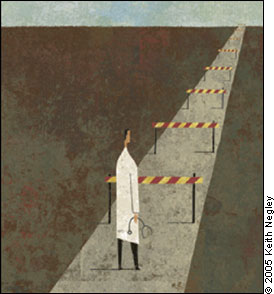
Controversial? Sure. Flawed? Arguably. Doomed? Probably not.
Fam Pract Manag. 2005;12(1):11

For many family physicians, I suspect, this issue's cover illustration depicts maintenance of certification only too accurately: nothing but hurdles in your path, as far as the eye can see. How true to life the portrait is, only time will tell.It appears to many that the Board mismanaged the transition from recertification to maintenance of certification.
In the worst-case scenario, our artist has captured the program's true personality: Self-Assessment Modules (SAMs) will turn out to be time-consuming, inconvenient, technically flawed wastes of time and money, and the only way the picture could have been made more lifelike is by replacing the hurdles with hoops for the doctor to jump through.
In the best-case scenario, the illustration will turn out to depict only what the program looks like here and now - from the starting line. The Maintenance of Certification (MOC) program will continually improve. Family physicians will find that it's actually useful, once they get used to it. They'll look forward to future SAMs and practice-improvement modules as ways to become better physicians. The hurdles will turn out to provide healthy exercise.
A brighter future?
Neither scenario is easy to accept entirely, although I lean toward the second one. After all, the American Board of Family Practice (just renamed American Board of Family Medicine, or ABFM) has a history of providing what most family physicians consider reasonable certification and recertification exams. The Board is not likely to go into the business of tormenting family physicians for no good end. That said, it appears to many that the Board mismanaged the transition from recertification to maintenance of certification both in implementation and in communication. As a result, family physicians feel blind-sided; some are threatening to abandon their certification; some disgruntled physicians who have tackled their first SAMs complain that they are paying to beta test software for the Board and disparage the SAMs as excessively academic and irrelevant to practice; those who have dial-up connections to the Internet understandably feel disadvantaged; and the Board finds itself reworking the hull of a ship that has set sail.
The fact that they are working on the hull should be good news, though physicians who recertified in 2003 and 2004 may find that hard to celebrate, since they're catching the brunt of the construction problems. In fact, our cover article in this issue quotes Thomas E. Norris, MD, president of the ABFM board of directors as saying, "We think communication is improving, and we think we have most of the technical problems fixed" (see "Are You Ready for Maintenance of Certification?"). Norris also acknowledges that they are working on a solution to the problems facing family physicians with dial-up access. And despite the wording of the Board's November letter to diplomates, there are signs that the Board may contemplate changes in the program that respond in some measure to input it has received from the AAFP and others. For instance, Norris comments in this issue's article that "the exact number of [self-assessment] modules required in each certification cycle is under review. At this time, we are requiring six, but this could change."
Got an opinion?
From what we've heard so far from readers, I would not be surprised to hear that many of you have strong opinions one way or the other about maintenance of certification and its implementation in family medicine. If you would like to share your opinion, here's your chance. E-mail Family Practice Management at fpmedit@aafp.org, fax us at 913-906-6010 or send a letter to Family Practice Management, 11400 Tomahawk Creek Pkwy., Leawood, KS 66211. We'll publish selected letters in upcoming issues.